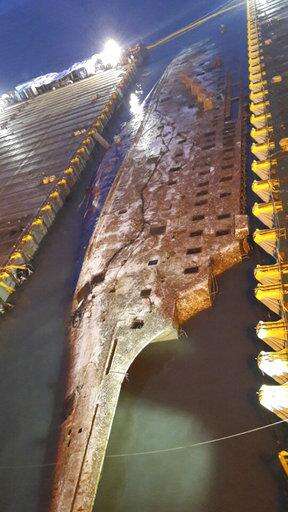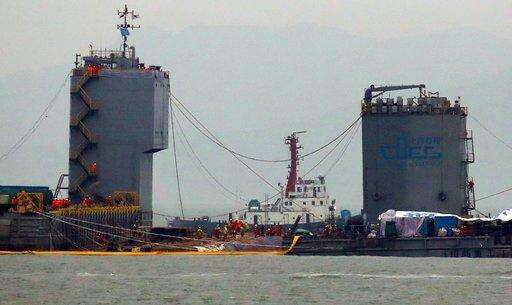In this photo provided by West Regional Headquarters Korea Coast Guard, workers prepare to lift the sunken Sewol ferry, center, in waters off Jindo, South Korea, Thursday, March 23, 2017. A 6,800-ton South Korean ferry emerged from the water on Thursday, nearly three years after it capsized and sank into violent seas off the country's southwestern coast, an emotional moment for the country that continues to search for closure to one of its deadliest disasters ever. (West Regional Headquarters Korea Coast Guard via AP)
The Associated Press
SEOUL, South Korea (AP) - How do you lift a corroded, 6,800-ton ferry lying more than 40 meters (130 feet) undersea, keeping it in one piece? It's a massive, delicate operation.
Salvaging the Sewol ferry which sank off South Korea's coast in April 2014 began Wednesday, and by Thursday morning, some parts of the ship emerged above the surface and were visible on live TV footage. But fully retrieving the ship and moving it to port will still take two weeks. An overview of the salvaging process for the Sewol:
___
THE SITE
The ferry sank in the Maenggol Channel off the southwestern coast. Maenggol means "fierce bones" and the waterway is notorious for dangerous currents. The initial searches when the ferry sank almost three years ago were hampered by strong currents and low visibility in the water, and two divers died while working on the search operations. The salvaging was started this week because of favorable weather conditions.
___
THE RECOVERY
The Sewol had been lying with left side buried, and South Korea wants to lift it as it is, rather than first pulling it upright. So divers put dozens of metal beams beneath the sunken ferry and connected them to two huge barges on the surface via 66 cables.
Salvage workers are now using those cables to slowly pull up the Sewol before they place it on a semi-submersible platform that will then move it to Mokpo port, about 90 kilometers (55 miles) away. The whole process, which involves emptying the Sewol of water and remaining fuel once it's loaded on that semi-submersible vessel, is expected to take about two weeks.
___
IN ONE PIECE
The ferry likely weighs more than 10,000 tons because of the debris and mud heaped inside it. But the government decided to hoist it intact largely because that's what relatives of the victims want.
Most of the 304 dead were high school students on a field trip to a southern resort island, and nine bodies still haven't been recovered. Their families hope that lifting the ship intact might reveal those bodies and more evidence about what caused the sinking.
Experts say breaking up the ferry would make the salvaging easier but also could damage any possible bodies or allow them to be swept away.
___
THE WORK
Fifty divers and up to 400 other workers are involved, many from a consortium led by China's state-run Shanghai Salvage Co., which was awarded the 85.1 billion won ($76 million) deal to salvage the ship. Shanghai's previous salvage work includes lifting the river cruise ship that sank in China's Yangtze River last year and killed more than 400 people.
Once it's at the port, investigators will enter the ferry to search the interior for bodies or clues to what caused sinking.
In this photo provided by West Regional Headquarters Korea Coast Guard, workers prepare to lift the sunken Sewol ferry, center, in waters off Jindo, South Korea, Thursday, March 23, 2017. A 6,800-ton South Korean ferry emerged from the water on Thursday, nearly three years after it capsized and sank into violent seas off the country's southwestern coast, an emotional moment for the country that continues to search for closure to one of its deadliest disasters ever. (West Regional Headquarters Korea Coast Guard via AP)
The Associated Press

In this photo provided by West Regional Headquarters Korea Coast Guard, workers prepare to lift the sunken Sewol ferry, center, in waters off Jindo, South Korea, Thursday, March 23, 2017. A 6,800-ton South Korean ferry emerged from the water on Thursday, nearly three years after it capsized and sank into violent seas off the country's southwestern coast, an emotional moment for the country that continues to search for closure to one of its deadliest disasters ever. (West Regional Headquarters Korea Coast Guard via AP)
The Associated Press
Workers prepare to lift the sunken Sewol ferry, center, in waters off Jindo, South Korea, Thursday, March 23, 2017. A 6,800-ton South Korean ferry emerged from the water on Thursday, nearly three years after it capsized and sank into violent seas off the country's southwestern coast, an emotional moment for the country that continues to search for closure to one of its deadliest disasters ever. (Park Gyung-woo/Hankookilbo via AP)
The Associated Press

In this photo provided by South Korean Ministry of Oceans and Fisheries, workers, left background, prepare to lift the sunken Sewol ferry, center, in waters off Jindo, South Korea, Thursday, March 23, 2017. A 6,800-ton South Korean ferry emerged from the water on Thursday, nearly three years after it capsized and sank into violent seas off the country's southwestern coast, an emotional moment for the country that continues to search for closure to one of its deadliest disasters ever. (South Korean Ministry of Oceans and Fisheries via AP)
The Associated Press

Workers prepare to lift the sunken Sewol ferry in waters off Jindo, South Korea, Thursday, March 23, 2017. South Korean workers on Thursday slowly pulled up a 6,800-ton ferry from the water, nearly three years after it capsized and sank into the violent seas off South Korea's southwestern coast, an emotional moment for a country that continues to search for closure to one of its deadliest disasters ever. (Lee Jin-wook/Yonhap via AP)
The Associated Press
A part of the sunken Sewol ferry is seen in waters off Jindo, South Korea, Thursday, March 23, 2017. Nearly three years after it capsized and sank into the violent seas off South Koreaâs southwestern coast, workers slowly pulled up the 6,800-ton ferry Sewol from the waters on Thursday. (Korea Pool/Yonhap via AP)
The Associated Press
In this photo provided by South Korean Maritime Ministry, two barges attempt to salvage the sunken Sewol ferry in waters off Jindo, South Korea, Wednesday, March 22, 2017. South Korean workers on Wednesday began the difficult process of raising a 6,800-ton ferry that sank in 2014, killing more than 300 people and triggering a public uproar that contributed to the recent ouster of Park Geun-hye as president. (South Korean Maritime Ministry via AP)
The Associated Press
Two barges attempt to salvage sunken Sewol ferry in waters off Jindo, South Korea, Wednesday, March 22, 2017. South Korean workers have started tests to determine if they can begin salvaging a 6,800-ton ferry that sank in 2014, killing more than 300 people and triggering a public uproar that contributed to the recent ouster of Park Geun-hye as president. (Lee Jin-wook/Yonhap via AP)
The Associated Press